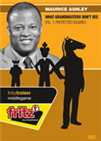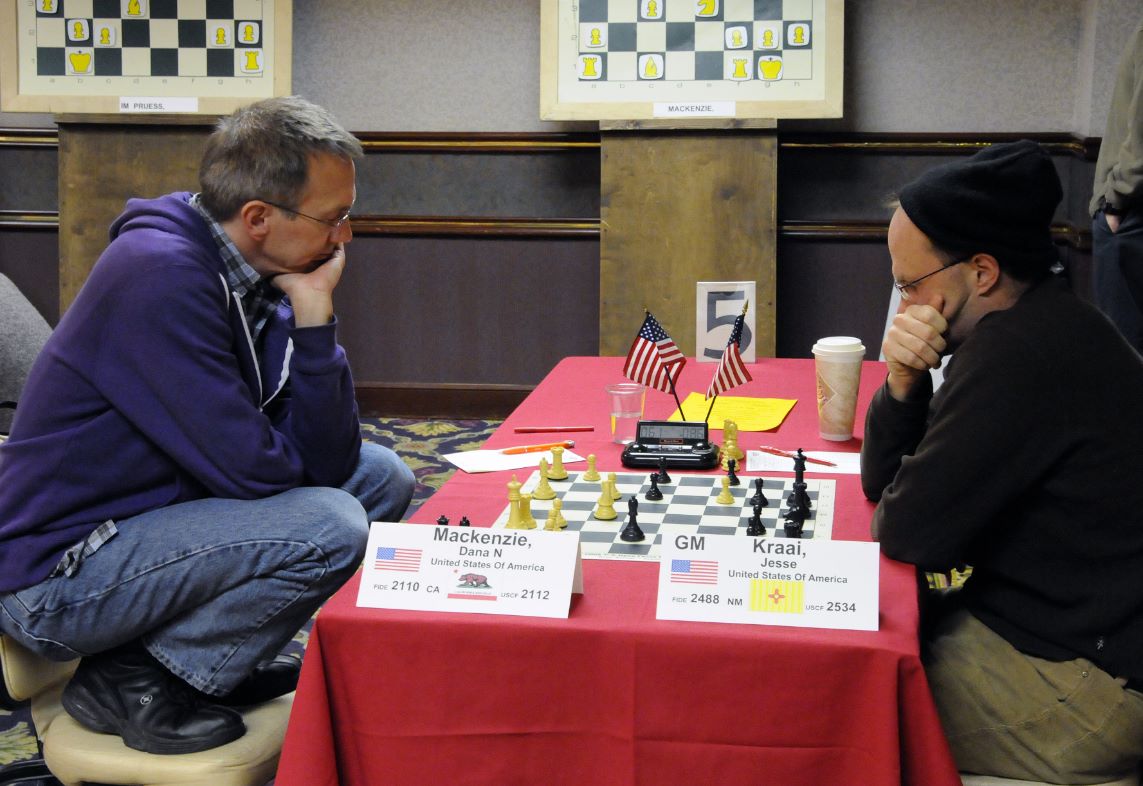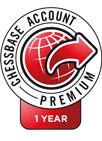Speelman's Agony #97
 Many times when a top player blunders, it is routinely described by the esoteric term „chess blindness.“ In the series What Grandmasters Don‘t See, chess trainer and world-class commentator Maurice Ashley strips away the myth, and for the first time explains why the root of these mistakes is more often based on the psychology of human learning.
Many times when a top player blunders, it is routinely described by the esoteric term „chess blindness.“ In the series What Grandmasters Don‘t See, chess trainer and world-class commentator Maurice Ashley strips away the myth, and for the first time explains why the root of these mistakes is more often based on the psychology of human learning.
In Volume 1 of the series, Ashley coins a new term Protected Squares, and shows how many errors occur on squares that seem invulnerable because they are clearly guarded by pawns.This week's pair of games both feature an extremely poisonous and very little-known gambit (I'd certainly never heard of it before) in the Grand Prix Attack against the Sicilian: The Bryntse Gambit.
They were played eight years apart by Dana Mackenzie a science and mathematics writer in his early sixties against two formidable opponents, IM David Pruess and Grandmaster Sergey Kudrin. In the first, he won while in the second he rather Agonisingly agreed a draw in a position which turned out to be clearly winning. He writes:
The two games I am submitting for the Agony/Ecstasy column both feature the same opening variation, the Bryntse Gambit. After 1.e4 c5 2.f4 d5 3.♘f3!? de 4.♘g5 ♞f6 5.♗c4 ♝g4?! 6.♕xg4!! White sacrifices his queen on move six — getting just two pieces and a pawn as compensation! Nevertheless, he obtains a nearly perpetual bind on the position.
Try it for yourself (play 6.♕xg4) against the engine on the diagram above!
The first game, played in 2006 against IM David Pruess, was my lifetime masterpiece. The game was the subject of a spirited post-mortem session including GM Victor Mikhalevski, GM Jesse Kraai, and IM Emory Tate, all of whom had watched the game. Jesse even said, “This is the greatest game ever played!” which of course was an overstatement but made me feel pretty good. The game has appeared in Chess Life, Informant, and Game of the Day on chessgames.com, so it definitely has gotten some publicity. But I would love to show it to your readers as well!

Mackenzie facing Kraai | Photo: Frank Brown / Dana Mackenzie Facebook page
Eight years later I got my chance to play a sequel. That game, my Agony game against GM Sergey Kudrin, has not been published anywhere to my knowledge, so your readers will be the first to see it. It could have been even better than the Pruess game, because I managed to get a won position against a grandmaster this time, which would have been my first win ever against a GM. But at a critical moment, Kudrin offered me a draw. To my shame, I accepted his offer, because a draw guaranteed me a substantial prize in the tournament (first place under 2300). I felt by no means certain of my ability to win the endgame, and I didn’t want to blow the prize money by making a blunder. However, postgame analysis showed that I had virtually a forced win in the final position, so my caution was completely unjustified.
 I’m sending you these games because I hope your readers will be as fascinated by this opening variation as I am! It is virtually nonexistent in opening books and offers rich scope for imagination. I would be thrilled if some IM or GM would see this and actually try the queen sacrifice as White. It would be especially exciting to see a human GM play it against a strong computer program like Stockfish or AlphaZero, because I think the human would have a chance to prevail. Computers do not understand this opening. Until then, I will have to be satisfied with torturing my home computer, as well as the occasional IM or GM!
I’m sending you these games because I hope your readers will be as fascinated by this opening variation as I am! It is virtually nonexistent in opening books and offers rich scope for imagination. I would be thrilled if some IM or GM would see this and actually try the queen sacrifice as White. It would be especially exciting to see a human GM play it against a strong computer program like Stockfish or AlphaZero, because I think the human would have a chance to prevail. Computers do not understand this opening. Until then, I will have to be satisfied with torturing my home computer, as well as the occasional IM or GM!
Professionally, I am a freelance mathematics and science writer. Perhaps I can put in a plug for my most recent book (co-written with Judea Pearl), The Book of Why: The New Science of Cause and Effect. It was published in 2018, and it was named as one of the top science books of 2018 by National Public Radio’s Science Friday program. I live in Santa Cruz, California, with my wife, our dog Daisy, our cat Max, and an ever-changing crew of foster kittens.”
Dana has annotated both games excellently in detail and I've added just a few comments of my own as JS. They're both wonderful games and I hope that readers enjoy them as much as I did.
Click or tap the second game in the list below the board to switch games
To avoid them or to play them, you have to know them. In two Volumes we see gambits such as Frankenstein-Dracula Gambit, the Cochrane Gambit, the Belgrade Gambit, the King's Gambit, Marshall Gambit, the Scotch Gambit, the Jänisch Gambit and many more.
Submit your games and win free Premium!
 At the airport, in the hotel or at home on your couch: with the new ChessBase you always have access to the whole ChessBase world: the new ChessBase video library, tactics server, opening training App, the live database with eight million games, Let’s Check and web access to playchess.com
At the airport, in the hotel or at home on your couch: with the new ChessBase you always have access to the whole ChessBase world: the new ChessBase video library, tactics server, opening training App, the live database with eight million games, Let’s Check and web access to playchess.comDid you enjoy the column and instructive analysis by GM Jonathan Speelman? Do you wish you could have a world-renowned grandmaster analysing your play? You can!
To submit your games just upload a PGN or ChessBase file (.pgn or .cbv archive), along with your name and e-mail address. Send one success story (Ecstasy) and one loss (Agony).
Tell why you chose them, where or when they were played. Please do include your email address, so Jon can reply, and preferably a photo of yourself for our article.
If your game is selected Jon will contact you personally, and not only will you get free detailed commentary of your games by one of chess’s great authors and instructors, and former world no. 4 player, but you also win a free three-month ChessBase Premium Account!
A three-month Premium subscription to ChessBase Account means you get:
- Premium access to the Playchess server with ratings, simuls, lectures, and live commentary of top games
- Access to all Web apps with no restrictions, such as the Cloud database, and more!
- Full access to the Video archive, which not only includes all the past lectures by Daniel King, Simon Williams and others, but also a large number of full ChessBase products you would normally need to buy in the ChessBase Shop but that you can view for free as a Premium subscriber.
See also:






















 I’m sending you these games because I hope your readers will be as fascinated by this opening variation as I am! It is virtually nonexistent in opening books and offers rich scope for imagination. I would be thrilled if some IM or GM would see this and actually try the queen sacrifice as White. It would be especially exciting to see a human GM play it against a strong computer program like Stockfish or AlphaZero, because I think the human would have a chance to prevail. Computers do not understand this opening. Until then, I will have to be satisfied with torturing my home computer, as well as the occasional IM or GM!
I’m sending you these games because I hope your readers will be as fascinated by this opening variation as I am! It is virtually nonexistent in opening books and offers rich scope for imagination. I would be thrilled if some IM or GM would see this and actually try the queen sacrifice as White. It would be especially exciting to see a human GM play it against a strong computer program like Stockfish or AlphaZero, because I think the human would have a chance to prevail. Computers do not understand this opening. Until then, I will have to be satisfied with torturing my home computer, as well as the occasional IM or GM!




